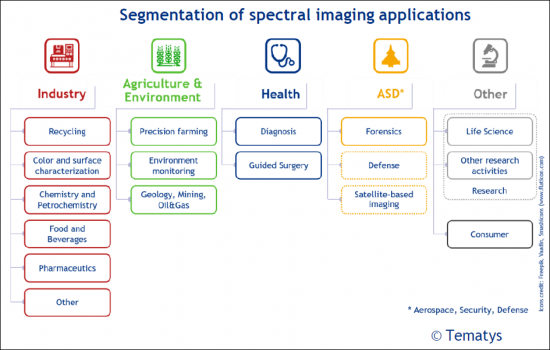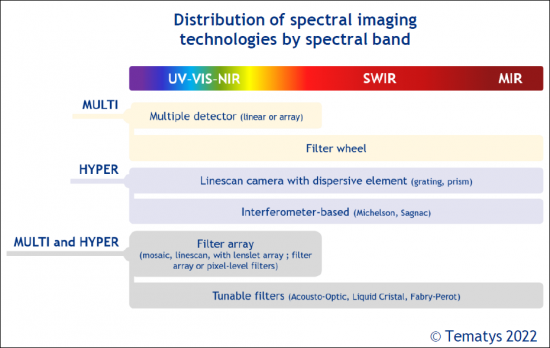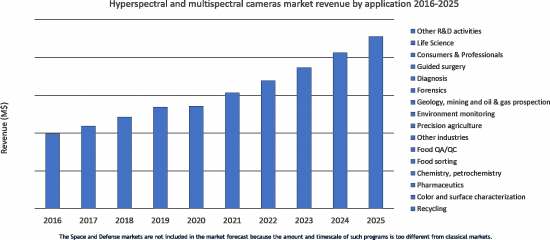 |
市场调查报告书
商品编码
1127459
光谱成像:最终用户需求、市场和趋势 (2022) - 高光谱和多光谱相机成为针对现场和在线应用的低成本工具Spectral Imaging: End-User Needs, Markets and Trends (2022) - Hyperspectral and Multispectral Cameras are Becoming Lower Cost Tools to Target On-field and In-line Applications |
||||||
处于转折点的市场
光谱成像(包括高光谱和多光谱),用于从卫星和飞机进行地球观测,自 2000 年代初以来已被工业界用于分类目的。.分拣是目前多光谱和高光谱相机最大的市场,收入也很大。
目前,光谱成像市场正处于发展的转折点。以不到 10,000 美元的成本,正在进行一项技术努力,以製造一种足够紧凑的相机,以便在无人机和工业生产线上实施。同时,还开发了一种稳健且易于使用的光谱数据分析方法。这些成就有望促进多/高光谱相机在现场和内联中的普及。预计未来几年光谱成像市场的复合年增长率将达到 20% 左右,到 2024 年销量将超过 10,000 台(不包括太空和军事市场)。

由社会问题驱动的市场
光谱成像可以结合空间和化学信息,解决三大工业和社会挑战。
- 预计工业 4.0 的部署将推动对能够实现复杂测量的经济高效的智能传感器的高需求。
- 对可持续和安全食品生产的需求:需要以高产量扩大大片区域,以便为不断增长的人口提供优质食品。
- 个性化医疗的发展:需要能够实现快速可靠诊断的无标籤、非侵入性、紧凑型工具。
对这种低成本和高级分析的需求将推动高光谱和多光谱相机在现场和在线应用中的采用。高增长市场包括食品和饮料、精准农业、颜色和表面表征、气体检测、药品质量保证/控制和医疗。

以低成本实现高级分析的技术开发
现场和工业应用需要低成本、便携且易于使用的系统。在硬件和软件层面取得了技术突破,降低了光谱相机的成本和尺寸,简化了数据处理方法。
最近,已经使用了创新技术,例如在 CMOS 检测器上进行晶圆级过滤器沉积,以及集成多个检测器阵列的相机设计。
借助这些技术,相机的价格现在达到了 5,000 美元到 12,000 美元之间。需要进一步取得进展才能达到 1,000-5,000 美元的目标价格,以供广泛的现场和工业采用。

在本报告中,我们分析了全球光谱成像市场,包括市场的最新情况和基本结构、按类型(多光谱相机、高光谱相机)以及按应用和光谱波段(数量为单位)。□金额基础),技术概述和比较,预期的应用领域,数据处理在未来市场发展中的重要性,最终用户的要求和对策。
内容
执行摘要
简介
分析总结
处于临界点的市场
- 驱动因素:对低成本高级分析的需求
- 价值炼和市场定义
- 市场参与者(2022 年)
- 市场数据和预测(2017-2025 年)
- 市场分析和遗留问题
软硬件技术趋势
- 简介
- 商业技术细分
- 多光谱成像技术:
- 空间扫描
- 快照
- 频谱扫描
- 高光谱成像技术:
- 空间扫描
- 快照
- 频谱扫描
- 每个光谱带的技术和相机成本
- 数据处理层:走向面向应用的解决方案
光谱成像的现状和有希望的未来应用领域
- 当前状态
- 下一个需要解决的大市场
- 工业 4.0(颜色/表面表征、製药)
- 可持续食品生产和食品安全(精准农业、食品选择、食品质量控制)
- 个性化医疗(医学诊断、引导手术)
附录
Hyperspectral and multispectral cameras are becoming low cost tools to target on-field and in-line applications.
Objectives of the report:
- Underline how spectral imaging can address key economical and societal challenges,
- Provide market data and forecast of spectral imaging cameras by application and by spectral band,
- Describe and benchmark the numerous hyperspectral and multispectral available technologies,
- Identify the most promising applications of hyperspectral and multispectral cameras,
- Highlight the importance of data processing in the development of the spectral imaging market,
- Understand end-users requirements for each Application, and the challenges to overcome for a wider adoption of spectral imaging.
Key Features of the report:
- Market revenue breakdown between multispectral and hyperspectral cameras
- Spectral imaging cameras market forecast by applications
- Benchmarking of different spectral imaging technologies
- Analysis of most promising applications
A market at a turning point
First introduced for earth observation from satellites and planes, spectral imaging (including hyperspectral and multispectral imaging) was adopted in industry in the 2000's, for sorting applications. Sorting is currently the biggest market of multispectral and hyperspectral cameras, in revenue.
The adoption in other industrial or in on-field applications remained low for three main reasons: the high cost of cameras, their large size and the huge amount of data to process and store. Currently, the spectral imaging market is at a turning point in its evolution. Technical efforts have been made to build cameras at cost below $10,000 and compact enough to be implemented on drones or in industrial lines. Meanwhile, robust and user-friendly methods for spectral data analysis have been developed. These achievements will lead to a wider adoption of multi/hyperspectral cameras for on-field or in-line applications. The spectral imaging market is expected to experience a high annual growth rate of around 20% in the coming years, reaching more than 10 000 cameras sold in 2024 (excluding the Space and Military markets).
The report provides the breakdown between multispectral and hyperspectral cameras. It also includes detailed market revenue and units forecasts by application and detailed analysis by market segment.

A market driven by societal challenges
With its ability to combine spatial and chemical information, spectral imaging addresses 3 major industrial and societal challenges:
- The deployment of industry 4.0, which induces a high demand for cost-effective smart sensors able to provide complex measurements,
- The need for sustainable and safe food production, which requires measurements on large areas and at high throughput to provide high food quality for an ever growing population,
- The development of personalized healthcare, that implies the need of label-free, non invasive and compact tools, giving a fast and reliable diagnosis.
These demands for low cost advanced analysis will drive the adoption of hyperspectral and multispectral cameras into on-field and in-line applications markets that will experience a high growth are Food & Beverages, Precision Agriculture, Color and Surface Characterization, Gas sensing, Pharmaceutics QA/QC, and Medical applications in the long-term.
In this report, we provide a detailed analysis of current and most promising applications of spectral imaging cameras. We describe the end-users needs and the remaining challenge for their widespread adoption in these markets.

Technology developments meet the demand for low cost advanced analysis
In on-field and industrial applications, the demand for low cost portable and easy-to-use systems is high. Technological breakthroughs are undertaken at hardware and software levels to decrease cost and size of spectral imaging cameras and simplify the data processing methods.
Recent advances take advantage of innovative technologies like deposition of filters on CMOS detectors at wafer level or innovative designs of cameras integrating multiple detector arrays.
With these technologies, cameras currently reach cost of $5 000 to $12 000. Further progresses are necessary to achieve the target price of $1 000 to $5 000 for broad adoption on field or in industry.

Table of Contents
Executive Summary
Introduction
- Study goals and objectives
- Information sources and methodology
- Glossary
- Context and Definitions
- Scope of the report
- List of companies
Highlights of the report
A market at a turning point
- Driver: demand for advanced analysis at lower cost
- Value chain and market definition
- Market players 2022
- Market data and forecasts 2017-2025
- Market analysis and remaining challenges
Hardware and software technology trends
- Introduction
- Segmentation of commercial technologies
- Multispectral imaging technologies:
- Spatial scanning
- Snapshot
- Spectral scanning
- Hyperspectral imaging technologies:
- Spatial scanning
- Snapshot
- Spectral scanning
- Technologies and cameras cost by spectral bands
- Data processing layers: towards application-oriented solutions
Spectral imaging current status and promosing applications
- Current status
- Next big markets to be addressed
- Industry 4.0 (Color and surface characterization, Pharmaceutics)
- Sustainable food production and food safety (Precision farming, food sorting and Food quality control)
- Personalized Health (Medical diagnosis and guided-surgery)
Appendices
- Methodology
- About TEMATYS













